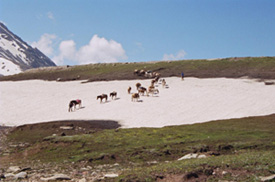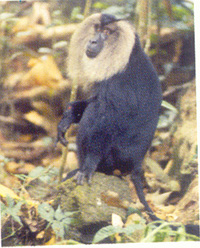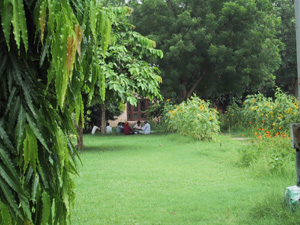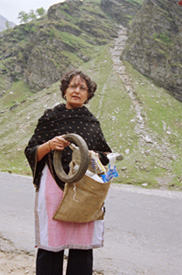Amazing Facts About Wildlife
 'I believe any trip in search of wildlife can be coupled with physical activity and elements of cultural diversity to form a thrilling opportunity ' 'I believe any trip in search of wildlife can be coupled with physical activity and elements of cultural diversity to form a thrilling opportunity '
John H.Eickert
I got no further up the highway to Leh and the bus gave up. In Shimla, the bus had just refused to start; here just out of Manali toward Rohtang Pass the engine destroyed itself creating a thick oily cloud of acrid black smoke. We all walked the eight kilometers
back to Manali. I sat in the ‘Mall’ in Manali drinking green tea and wondering what was going on. The journey to Ladakh had certainly been full of surprises and delays. I wondered if there were more surprises in and around Manali. What I found out was Manali,
the Beas River, and the Kullu Valley are a destination all to their own and often missed on the rush to Leh. I visited the Tibetan market in Manali, the gorge at Kothi where the Beas squeezes desperately between rock walls, the Parvati River which runs hot
and cold, an ancient fort built by Raja Bhosal at Nagar, and walked two treks, walking from Manali to Dharamsala, but first over the Chandrakhani Pass and into the Valley of the Gods.

I simply could not resist a place named the Valley of the Gods. As the legend goes Jamlu, who was the principle holy man of the Malana Valley was carrying a basket containing all the deities important to Hinduism over Chandrakhani Pass on his way to Manali.
A strong westerly wind struck Jamlu at the very summit of Chandrakhani causing him to drop the basket. The prevailing wind blew all the deities back into the Malana Valley. Jamlu realized the deities wished to remain in the valley and so it came to be known
as the Valley of the Gods. The trek begins in Nagar and can be done in six days. The walk winds through deodar trees over Chandrakhani where there is a magnificent view of the mountain Deo Tibba and its glaciers through the village of Malana and ending at
Manikaran on the banks of the hot\cold Parvati River. There is a trail beyond Manikaran leading to the glacier and the source of the Parvati near Khirganga. I did talk with a university group who were just returning from Khirganga and they were all most excited.
For me, well, there are too many adventures and not enough time. I always promise myself to return.
I did return to Manali after the trek, taking the bus from Manikaran. It seemed odd that a trek with such fantastic scenery, brief time commitment, and only a short distance north of Delhi had little popularity. Malana has a refreshing yet remote feel. The
snow-clad peaks, the deodar, the rushing water, and chilling winds create a memorable experience. The only amenity missing was wildlife. Several villagers in Malana told me there were leopards in the mountains, but I did not ‘spot’ one. After a soak in the
hot springs at Manikaran, I made it back to Manali where I prepared for the epic, 18-day journey to Dharamsala. I hope all of you are well, cheers!
(Photograph of Rohtang Pass by Dr. Susan Sharma)
Visit
http://www.numbum.net or call NumBum Adventurers at 406-777-2228
|
Answers To Quiz Of The Month
This month no one has given all right answers, chattorajd@yahoo.com has given 7 right answers. Here are correct answers.
Right Answers to
Captive Elephants
|
| 1.Elephants live more than 70 years in the wild. In captivity ( zoos) their life span is reduced to an average of ……. |
|
50 years |
14 years |
30 years
|
|
| 2.The London Zoo recently closed down its 170 year old elephant exhibit due to
|
|
recognition that elephants deserve more than chains |
the zookeeper being crushed to death |
both the above reasons
|
|
| 3.Captivity in any form rob elephants of one of their most basic needs, namely…….. |
|
social companionship |
space |
natural food sources
|
|
| 4.Captive elephants in Assam have taken to begging on the streets due to ……… |
|
lack of timber transport work |
returning to wild not possible as these are bred in captivity |
both the above
|
|
| 5.The number of captive elephants in India is
|
|
| 6.Among the 600 captive elephants in Kerala ……………. % are with private individuals. |
|
| 7.Implantation of micro chips in the ear of captive elephants help the U.P Government …. |
|
track the wherabouts of the elephant |
keep a tab on the health of the elephant |
help catch cheats who keep more than one elephant under a single ownership certificate.
|
|
| 8.To deal with 30 stressed and unhappy captive elephants in Delhi, …… |
|
Anti depression drug `prozac` is being used |
the elephants are made to work harder so they stop wallowing in self pity |
An `elephant whisperer` from U.S has been employed
|
|
| 9.In 1882 P.T. Barnum purchased `Jumbo` and made him a star of his circus. Jumbo was an elephant from …. |
|
| 10.The largest number of captive elephants, 6800, are found in ……………… |
|
Thailand |
Myanmar |
SriLanka
|
|
Please try our quiz for the current month on
Non human primates
|
Endangered
By Dr. Susan Sharma
Status: Endangered
The lion - tailed macaque is the ancestor of all Asian macaques. Endemic to the Western Ghats of India, it occurs in Karnataka, Kerala and Tamil Nadu. The population is severely fragmented (IUCN 2002) and the current population is estimated
at around 4000( ENVIS study). 
Threats and Reasons for Decline:
The major reason for its decline appears to have been habitat loss due to the spread of agriculture and teak, coffee, tea and other plantations. Formerly it was extensively captured for the pet trade, zoos and research, as well as for use
in Oriental medicine.
Characteristics;
As well as having a tail like a lion's, this species also has a mane. They are also known as wanderoos. There is no sub species of this primate.
The lion-tailed macaque is omnivorous. It is mainly arboreal, although it does occasionally descend to the ground.
Lion-tailed macaques are active during the day. They spend the majority of their time in the trees, and are cautious when on the ground. Groups of lion-tailed macaques range from 4 - 34 individuals. They usually contain about 10 - 20 individuals, including
1 - 3 adult males. The species has been studied in detail for over a decade in the Anamalai Hills. Compared to most other macaques, the lion tailed has a very low birth rate. Hence its capacity to recover from drastic population reductions is low.
Conservation Problems;
Hunting and habitat destruction are major problems in conserving this species. The population in Kodagu forests has reduced drastically due to poaching. Hunting has been reported in Nilambur, Cardamom Hills and Silent Valley. Given the low
birth rate and high age at first birth, the lion tailed macaque does not have the ability to recover from even low levels of hunting.
(Photograph of lion tailed macaque by Ajith Kumar, ENVIS)
|
Gardening for wildlife
By Promilla Chaturvedi
In big towns and cities there are concrete buildings all around us and very little greenery. During development process we developed industries and vehicular traffic also increased. The human activities,
industries and vehicular movement jointly pollute the environment.
To combat this pollution problem we need forests/ trees. Since there is no forest in the cities we need to develop gardens to combat the problem.
GARDENS IN BIG TOWNS
 The gardens can be big, medium and small. Usually big gardens are developed by government, industrial-houses and institutions. And medium size and small gardens are developed and maintained by individuals. In big cities while living in flats, the size of
garden becomes even smaller. We have terrace gardens and can have gardening in pots also. The gardens can be big, medium and small. Usually big gardens are developed by government, industrial-houses and institutions. And medium size and small gardens are developed and maintained by individuals. In big cities while living in flats, the size of
garden becomes even smaller. We have terrace gardens and can have gardening in pots also.
Small Gardens
In laying a garden few things are important-
The climatic conditions,
The size of the garden, The drainage, Direction of sun, And user’s choice.
For laying a garden the whole garden area needs to be dug up. If the soil is fine then the manure- preferably well rot cow dung manure and neem cake, should be added to the ground and mixed well in the soil.
Flood the garden. Before the soil is totally dry dress up the whole area.
 Mark the border along the grill or boundary of the house. In a formal layout 3ft wide bed will be sufficient, and in an informal layout the width varies. Here one can have low mounds also at sides. Next
the path has to be marked from the entrance of the house till boundary. In a small garden there is no scope for garden paths or paved sitting area. The rest of area is left as lawn. Mark the border along the grill or boundary of the house. In a formal layout 3ft wide bed will be sufficient, and in an informal layout the width varies. Here one can have low mounds also at sides. Next
the path has to be marked from the entrance of the house till boundary. In a small garden there is no scope for garden paths or paved sitting area. The rest of area is left as lawn.
In a garden a focal point is advised. The garden being small, it could be a small beautiful/flowering tree or a flowering large shrub or a climber trained on a garden frame. The permanent plants-the flowering and foliage shrubs can be planted. The perennials,
annuals and bulbous plants fill up the gaps in border. If space permits few flowering climbers can also be planted at the desirable places.
Lay the path and grass the remaining area.
The selection of plants and the tree is determined by the climatic conditions and the direction of sun. In sun one can select out of any of the flowering shrubs recommended for the area but for shade gardens
the choice is limited.
More on gardening next month!
|
Members Speak
FIND THE ODD ONE OUT OF THE GROUP
1.Cobra .
Olive Ridley
Python
Rattlesnake
Viper
2.Albatross
Cormorant
Frigatebird
Goose
Terns
3.Blackbird
Hawk
Nightingale
Robin
4.BlackMamba
Mice
Porcupines
Rats
Squirrels
The answers are.
1. OliveRiddley,which is a marine turtle,the rest are
snakes.
2. Goose,which is a wild fowl, the rest are sea birds.
3. Hawk,which is a bird of prey,the rest are song birds.
4. Black mamba,which is a snake,the rest are rodents
JOKE
There lived a man who vowed not to let anything go. On his birthday,he went to a restaurant with his
son.After eating,he decided to gather the leftovers.He then asked the waitress to give him a polythene
bag.'Please I want to wrap the leftovers home for my 'Chimpanzee and elephant.They are in the same
cage'.The son surprisingly looked at the father and asked 'please daddy when did you start keeping 'wilds
in the house and in the same cage?
(Sampson Ayensu Amoo, Wildlife Club of Ghana, Adviser)
|
News and Views
News……..
By Dr.Susan Sharma
This month's ezine has our usual features plus a new series on 'Gardening' written by an experienced landscape specialist, Promilla Chaturvedi. As many or most of our members are urbanites, her tips on gardening starting with a small garden will, we hope, motivate
many to take up gardening. Let us give the butterflies and birds a home too. 
The zookeeper tells a tragic tale making us realize yet again how bad "plastic" can be. We seem to be littering the mountains and valleys too, once considered pristine. When we go up to Rohtang Pass from Manali by road, the forest department hands over a huge
paper bag with a request that we must bring back all waste in this bag. The idea is excellent, since it motivates one to collect waste plastic wrappers etc you find around you when you are at the Pass. While on top of the Rohtang Pass we managed filling up
our bag very fast which my friend is holding up in the picture.
Bombay Natural History Society (BNHS) is planning to start a branch office in New Delhi. To start with they are planning to set up a Conservation Education Centre at Asola-Bhatti Wildlife Sanctuary, Delhi (near Tughalakabad) in collaboration with Government
of NCT of Delhi to create awareness about nature conservation among children and adults. Project activities will involve developing interactive educational displays, designing nature trails, developing educational resources for teachers, teacher training,
outreach programmes in schools in Delhi, interaction with NGOs and decision makers. The project team will be based at Asola-Bhatti Wildlife Sanctuary, Delhi. BNHS has advertised for three Delhi based professionals to join them. You can read the details of
their requirement by
clicking here.
And Views…………….
( These views are taken from the visitors' book kept at "Wildscapes -Nature and Wildlife photo exhibition which was held from May 8 to 12 , 2004 at India Habitat Centre, New Delhi. )
" Some like paintings,
Some speak to you,
Animals are always
An endearing subject
And have been shot
With great love
Which is apparent in the photographs"
------ Veena Chaturvedi
" All of them were really nice and these animals and birds should remain like this. This is our responsibility.
-----Pawan Sharma
"Wonderful photos, what a fascinating country, with stunning wildlife."
-----Jeannine Grant
|
Zoo
 |
Toby Ninan retired from Delhi Zoo about two years back. With his varied experiences with the wild animals in the zoo, he is the right person
to direct your queries to. Hear what Ninan has to say about his life and chosen career! |
The Zebra and the ostrich, used to occupy the same enclosure, which was really ideal for this combination of animal display.
It consisted of nearly 2 acres which was sparsely wooded at the viewing moated end and hedged in behind with a six feet high link mesh fence. The areas in the rear have somewhat thicker cover of trees and
bushes, which forms an ideal place when the occupants need some privacy or a cooler spot away from the prying eyes of visitors. However, due to the fact that there are a couple of grassy mounds behind the fencing, it is a fine spot for researchers to conduct
their observations in peace and also for the ever present kootchie-coo couples who would want nothing more than to be left alone.

Last month, I told you about our male zebra Raju, who not only saved me but many of our keepers from the attack of the ostrich. Well, he was a fine specimen whom everyone admired. He was also a good breeder- Raju and his mate multiplied to five heads pretty
soon, enabling the zoo to exchange the offspring with other zoos for exotics like the 'red lechwe'.
We expected that the zebra would continue to breed well and again we would have plenty to spare. But that was not to be and tragedy struck.
Raju was not very friendly to human beings, (though he helped keepers in distress!) but would condescendingly allow his keeper to stroke his mane at times. He was very devoted to his mate and the two formed
a perfect made-for-each-other couple.
One morning we found the female lying dead. Poor Raju was standing close by, absolutely inconsolable. Sudden deaths, especially in bigger animals are really very rare and the carcass has to go through an
exhaustive post-mortem. The reason for this death was not very difficult to decipher. There was a complete block of the intestines by a plastic bag! It seems some warped person gave the animal some nice picnic-packed lunch in a plastic bag, which in turn blocked
the intestine and brought about its death.
Raju was devastated and refused to eat or drink anything. However, after prolonged coaxing he did eat something from the hands of his keeper. We thought he would come out of his dejection in a day or two
but this was not to be and early next day-close to where his mate died, he was also found dead.
An extensive post mortem was done including chemical analysis of the gut and intestinal contents, blood analysis etc. but nothing unusual was found.
My good friend Raju had died heartbroken and had left us all absolutely distraught. Our zebra population was wiped out by nothing more than the action of a twisted individual with a plastic bag!
|